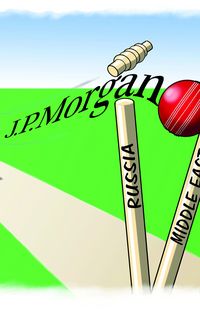Record-breaker
It was the most eagerly awaited bond deal of the year. But could Saudi Arabia match the hype around its debut transaction?
The answer was an emphatic “yes”. Not only did the kingdom issue the biggest-ever publicly syndicated sovereign bond deal and the biggest transaction by any emerging markets issuer with its US$17.5bn offering from a US$67bn order book, but it also created a new benchmark for the Middle East region.
The kingdom stunned the market with its trade as it broke with conventional wisdom in the way the transaction was split.
Saudi Arabia (A1/A–/AA–) issued its record deal through three tranches: US$5.5bn of five-year bonds; US$5.5bn of 10-year notes; and a US$6.5bn 30-year tranche.
Usually in jumbo trades, the longest-dated note tranche is the smallest, to keep costs down. But Saudi turned that thinking on its head to take advantage of demand for tenor at a time when global yields were severely compressed.
Momentum for the 30-year tranche was driven by Asian accounts, such as life insurers, vindicating a decision to undertake a non-deal roadshow that visited Taipei and Singapore in July.
Asian investors took 22% of the 30-year tranche, though US buyers got the most with 44%.
Pricing on that note tranche was attractive for both investors and the issuer. The yield of 4.623% offered a more than 200bp pick-up over where 30-year Treasuries were trading at the time. Equally, the 4.5% coupon was inside the 4.625% that higher-rated Qatar (Aa2/AA/AA) paid for its June 2046s.
Not that Saudi was comparing itself to Qatar. It had a range of proxies – across the region, across the emerging markets, across oil producers, and across debut sovereign issuers.
While the 30-year tranche grabbed the headlines, the five and 10-year note issues were also well executed. The shorter-dated bonds drew plenty of interest from Middle East banks, albeit in terms of the actual allocation US and European investors got the biggest portion, with a combined share of 74%.
The 10-year tranche, meanwhile, was like a traditional 144A/Reg S emerging markets offering at that tenor, appealing to all investor types. It was allocated mostly to institutional accounts from Europe and the US, though Middle East investors also got a decent chunk, taking nearly a quarter of the paper.
All three tranches were priced 20bp–25bp inside initial marketing levels, with the bonds rallying by 0.5–1.5 points in the secondary market.
That secondary performance was as important to the Saudis as the actual fundraising, given that it wants to build a sustainable borrowing programme.
Indeed, the bonds had an impact across the region, helping to bring down the Sibor rate, muting worries about the riyal in the FX forward market and leading to a tightening of other regional issuers’ curves.
Citigroup, HSBC and JP Morgan were the global coordinators on the 144A/Reg S transaction.
To see the digital version of this review, please click here.
To purchase printed copies or a PDF of this review, please email gloria.balbastro@tr.com


